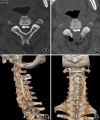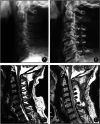Efficacy and Safety of Ultrasonic Bone Curette-assisted Dome-like Laminoplasty in the Treatment of Cervical Ossification of Longitudinal Ligament
- PMID: 33403818
- PMCID: PMC7862153
- DOI: 10.1111/os.12858
Efficacy and Safety of Ultrasonic Bone Curette-assisted Dome-like Laminoplasty in the Treatment of Cervical Ossification of Longitudinal Ligament
Abstract
Objective: To assess the efficacy and safety of ultrasonic bone curette-assisted dome-like laminoplasty in the treatment of ossification of longitudinal ligament (OPLL) involving C2 .
Methods: A total of 64 patients with OPLL involving C2 level were enrolled. Thirty-eight patients who underwent ultrasonic bone curette-assisted dome-like laminoplasty were defined as ultrasonic bone curette group (UBC), and 28 patients who underwent traditional high-speed drill-assisted dome-like laminoplasty were defined as high-speed drill group (HSD). Patient characteristics such as age, sex, body mass index (BMI), symptomatic duration, and other information like the type of OPLL, the time of surgery, blood loss, C2 -C7 Cobb angle change and complications were all recorded and compared. The Japanese Orthopaedic Association (JOA) score, the nerve root functional improvement rate (IR), and the visual analogue scale (VAS) were used to assess neurological recovery and pain relief. The change of the distance between the apex of ossification and a continuous line connecting the anterior edges of the lamina was measured to assess the spinal expansion extent. The measured data were statistically processed and analyzed using SPSS 21.0 software, and the measurement data were expressed as mean ± SD.
Results: In ultrasonic bone curette (UBC) group and high-speed drill group (HSD) group, the average time for laminoplasty was 52.3 ± 18.2 min and 76.0 ± 21.8 min and the mean bleeding loss volume was 155.5 ± 41.3 mL and 177.4 ± 54.7 mL, respectively, with a statistically significant difference between the groups. Both groups demonstrated a significant improvement in neurological function. However, the VAS score in UBC group was lower than in HSD group at the 6-month follow-up (P < 0.05), but there was no significant difference at 1-year follow-up. We found that the loss of lordosis was 1.5° ± 1.0° in UBC group, which is significantly lower than that of HSD group at 1-year follow-up (3.8° ± 1.2°, P < 0.05). According to the change of canal dimension, we found that the expansion extent of the spinal canal in UBC group was similar to that of HSD group (P > 0.05). Only one patient in the UBC group and five patients in the HSD group displayed cerebrospinal fluid (CSF) leakag.
Conclusions: With the use of ultrasonic bone curette in OPLL dome-like decompression, the decompression surgery could be completed relatively safely and quickly. It effectively reduced the amount of intraoperative blood loss and complications, and had better initial recovery of neck pain.
Keywords: Axis; Dome-like laminectomy; Laminoplasty; OPLL.
© 2021 The Authors. Orthopaedic Surgery published by Chinese Orthopaedic Association and John Wiley & Sons Australia, Ltd.
Figures



References
-
- Nakamura I, Ikegawa S, Okawa A, et al Association of the human NPPS gene with ossification of the posterior longitudinal ligament of the spine (OPLL). Hum Genet, 1999, 104: 492–497. - PubMed
-
- Okamoto K, Kobashi G, Washio M, et al Dietary habits and risk of ossification of the posterior longitudinal ligaments of the spine (OPLL); findings from a case‐control study in Japan. J Bone Miner Metab, 2004, 22: 612–617. - PubMed
-
- An HS, Al‐Shihabi L, Kurd M. Surgical treatment for ossification of the posterior longitudinal ligament in the cervical spine. J Am Acad Orthop Surg, 2014, 22: 420–429. - PubMed
-
- Lee SE, Jahng TA, Kim HJ. Surgical outcomes of the ossification of the posterior longitudinal ligament according to the involvement of the C2 segment. World Neurosurg, 2016, 90: 51–57. - PubMed
-
- Haller JM, Iwanik M, Shen FH. Clinically relevant anatomy of high anterior cervical approach. Spine (Phila pa 1976), 2011, 36: 2116–2121. - PubMed
MeSH terms
Grants and funding
LinkOut - more resources
Full Text Sources
Other Literature Sources
Medical
Miscellaneous

